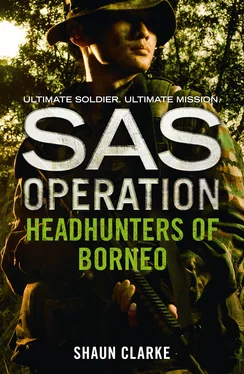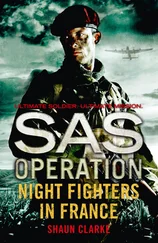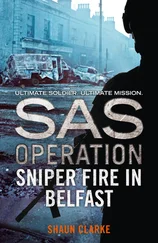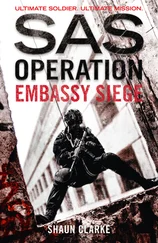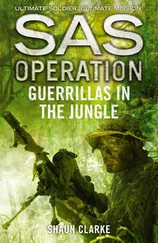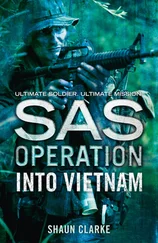As Sanderson stretched out on the grassy ground beside his basha and lit up a cigarette, the others extinguished the flames from the burning hexamine blocks in their portable cookers, then followed Hunt into the dense undergrowth. Surprisingly, they found themselves walking along a narrow, twisting path, barely distinguishable in the gloom beneath the overhanging foliage.
Terry, the least experienced in the group, immediately felt oppressed and disorientated by the ulu . He had stepped into a vast silence that made his own breathing – even his heartbeat – seem unnaturally loud. Instead of the riot of birds, wildlife, flowers and natural colours he had expected, he found only a sunless gloom deepened by the dark green and brown of vine stems, tree-ferns, snake-like coils of rattan, an abundance of large and small palms, long, narrow, dangerously spiked leaves, gnarled, knotted branches – and everywhere brown mud. Glancing up from the featureless jungle, he was oppressed even more by the sheer size of the trees which soared above the dense foliage to dizzying heights, forming vertical tunnels of green and brown, the great trunks entangled in yet more liana and vine, disappearing into the darkness of their own canopy, blotting out the sunlight.
Looking up, Terry felt even more dizzy and disorientated. In that great silent and featureless gloom, he felt divorced from his own flesh and blood. His racing heart shocked him.
Though the hike took only five minutes, it seemed much longer than that, and Terry sighed with relief when the group emerged into the relative brightness of an unreal grey light that fell down through a window in the canopy of the trees on the thatched longhouses of the kampong spread out around the muddy banks of the river. The dwellings were raised on stilts, piled up one behind the other, each slightly above the other, on the wooded slopes climbing up from the river. Some, Terry noticed with a tremor, had shrunken human heads strung above their doors. The spaces below and between the houses, where the ground had been cleared for cultivation, were filled with the Iban villagers – also known as Sea Dyaks because they had once been pirates – who, stripped to the waist, male and female, young and old, were engaged in a variety of tasks, such as cooking, fishing, laundering, picking jungle fruit – figs, durians, bananas and mangos – or working in a small, dry padi , where their basic food, rice and tapioca, was grown. This they did with no great expenditure of energy, except when playing odd games and giggling. Their longboats were tied up to a long, rickety jetty, bobbing and creaking noisily in the water. Buffalo and pigs also congregated there, drinking the water or eating the tall grass as chickens squawked noisily about them.
‘They fish in that river,’ Hunt explained. ‘They also hunt wild pig, deer, birds, monkeys and other animals, using traps and the odd shotgun, but mostly blowpipes that fire poisoned arrows. Annoy them and they’ll fire them at you – so don’t steal their women!’
Terry was blushing deeply, Pete and Alf were gawping, and Dead-eye was staring impassively as a group of bare-breasted women, giggling and nudging each other, approached behind a very old, wizened man who was naked except for a loincloth and, incongruously, a pair of British army jungle boots. Obviously the headman, he raised a withered arm, spread the fingers of his hand, and croaked the one word of English he had learned from Sergeant Hunt: ‘Welcome!’
Two weeks later, Terry had stopped blushing at the sight of the bare-breasted women, but felt even more disorientated and removed from himself. This had begun with his first short trek through the awesome silence and gloom of the ulu , but was deepened by his daily visits to the kampong and his increasingly intimate interaction with the Ibans. They were so gentle and good-natured that he could not imagine them as pirates, let alone as the headhunters they obviously were, judging by the shrunken heads on prominent display. Certainly, however, they lived a primitive life of fishing in the rivers, hunting animals with blowpipes, tilling the kampong’s one rice-and-tapioca padi , and constantly maintaining their longhouses with raw materials from the jungle. They also engaged in amiable barter, trading jungle products such as timber, rattan, rice, tapioca, fruit, fish, even the swiftlet’s nests used for Chinese soup, in return for clothes, boots, rifles, tins of baked beans, chewing gum and cigarettes. Bartering, from the point of view of the SAS troopers, was the easiest way to the affections of the villagers, leading to much giggling and backslapping.
Once this had become commonplace, however, the men started winning the hearts and minds of the Ibans in other ways: Pete showed them how to use explosives for various small tasks, such as blowing fish out of the water; Alf ran a daily open-air clinic to deal with their real and imagined illnesses; Terry entertained them by tuning his shortwave radio into various stations, which invariably reduced them to excited giggles; Dead-eye trained some of them in the selective use of weapons; and Hunt and Sanderson took turns with Dead-eye to teach English to the more important men of the kampong.
The SAS men spent most of their waking hours with the Ibans, which made for a long and exhausting day. Invariably, this began at first light when, just after breakfast, they would make the short hike through the ulu from their hidden camp to the kampong. After an average of twelve hours in the kampong, eating their lunch with the Ibans, they would make their way back to the camp, invariably at last light and concealing their tracks as they went, to have a brew-up and feed gratefully off compo rations.
The Ibans were very sociable, and often, in the interests of good manners and improved relations, the troopers would be obliged to stay in one of the longhouses to partake of native hospitality. For all of them, this was pure torture, particularly since the villagers’ favourite meal was a stinking mess called jarit , which they made by splitting a length of thick bamboo, filling it with raw pork, salt and rice, and burying it for a month until it had putrefied. Indeed, while Dead-eye and Hunt were able to digest this stinking mess without bother, the others could only do so without throwing up by washing it down with mouthfuls of tapai , a fierce rice wine which looked like unfermented cider, scalded the throat and led to monumental hangovers. Nevertheless, when drunk through straws from large Chinese jars, it was potent enough to drown the stench and foul taste of the jarit .
The eating and drinking, combined with the accompanying entertainments, in which the SAS men were obliged to dance for the villagers, was made no easier by the fact that many families shared a single longhouse and the air was fetid not only from their sweat and the heat. Also, because they used the floor as a communal toilet, urinating and defecating through the slatted floor onto the ground below, the pungent air was thick at all times with swarms of flies and mosquitoes.
Luckily for the SAS men, they were called upon to explore the surrounding area and fill in the blank spaces on their maps, showing waterways suitable for boat navigation, tracks that could be classified as main or secondary, distances both in linear measurements and marching hours, contours and accessibility of specific areas, primary and secondary jungle ( belukar ), and swamps, and areas under cultivation ( ladang ). They also filled their logbooks with often seemingly irrelevant, though actually vitally important, details about the locals’ habits and customs, their food, their state of health, the variety of their animals, their weapons and their individual measure of importance within the community. Last but not least, they marked down potential ambush positions, border crossing-points, and suitable locations for parachute droppings and helicopter landings. While this work was all conducted in the suffocating humidity of the ulu , it was preferable to socializing in the fetid longhouses.
Читать дальше
